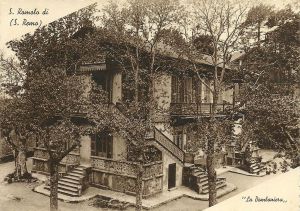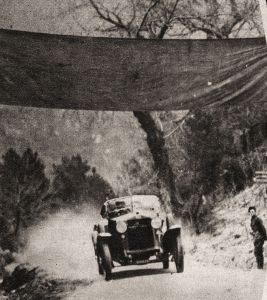History of San romolo
Between the 7th and 8th century the area of the present Saint Romulus was inhabited by the Genoese bishop Romulus, the future patron saint of the city. 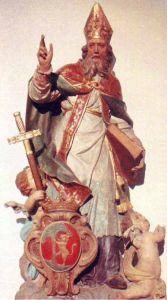 Before being elected bishop of Genoa, Saint Romulus lived for many years in the woods surrounding the Villa Matutiana, preaching the Gospel and profitably continuing the conversion to Christianity of the local population already started by his predecessors. It seems that the saint came to our area to save himself from the constant harassment that the Longobards, of Aryan faith, carried out against the followers of Catholicism, or perhaps even to relieve the burdensome tasks that engaged him in Genoa by moving to a more isolated and peaceful location.
Before being elected bishop of Genoa, Saint Romulus lived for many years in the woods surrounding the Villa Matutiana, preaching the Gospel and profitably continuing the conversion to Christianity of the local population already started by his predecessors. It seems that the saint came to our area to save himself from the constant harassment that the Longobards, of Aryan faith, carried out against the followers of Catholicism, or perhaps even to relieve the burdensome tasks that engaged him in Genoa by moving to a more isolated and peaceful location.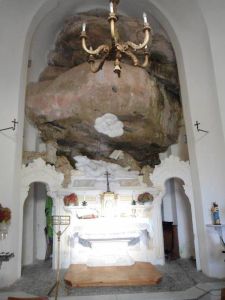
As soon as he arrived at Villa Matutiana, Romulus chose as his residence a solitary grotto situated on the slopes of Mount Bignone, later called Bauma, in perfect harmony with the spirit of penitence of the time in which numerous hermitages and monasteries were founded in secluded and uninhabited places.
However, it is probable that near the place chosen by the saint as his hermitage there already existed a fortified inhabited structure, which was then called "castellum de Cairasco", a name perhaps derived from that of the stream located right near the Bauma, called "rian de Cairasca".
This fortification could also correspond, or be a more recent reconstruction, of the ancient pre-Roman castle, which, as we have seen, was located in the same area.
According to a reliable historical hypothesis, however, San Romolo would not have chosen a completely isolated place as its home, but a place already home to a pastoral and agricultural community, whose origins date back to Roman times. During his stay in Matuzian land, the saint carried out an intense preaching and evangelising activity, going both to the centres of the coastal strip and to the small villages of the hinterland and performing numerous miracles.
The legend that soon spread around this character also tells that St. Romulus defended the village inhabited by the Matuzians from the attack of marauders and pirates, perhaps the Saracens themselves, praying with their arms raised or even running away with a brandished sword.
Even after being elected bishop of Genoa, Romolo went several times to visit Villa Matutiana, where he remained for a long time.
In Bauma itself, where he had spent so many years in prayer and penitence, he died on 13th October of an unspecified year, however, not without some uncertainty, in the second half of the 7th century or at the beginning of the 8th.
The permanence of San Romolo in the Matuziano territory assumed a particular importance for the religious and social life of the inhabitants of the small centre, who drew from the example of holiness and moral rectitude offered by him the necessary courage to overcome the sufferings and humiliations deriving from the numerous incursions that then and in the following centuries had to suffer from barbarians and pirates. In particular, his intercession with the poorest and most disinherited infused Matuzians with new confidence in the future and in their moral and religious qualities.
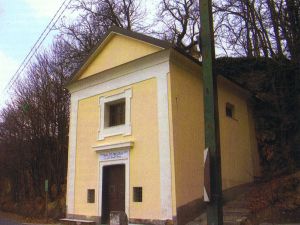 The same place where he died, the famous Bauma, where long afterwards a small chapel would be built following a series of miracles that happened on the site, became the destination of numerous pilgrimages by the saint's many faithful, who came from the most varied places. After his beatification and canonization, St. Romulus, who had been buried in the crypt of the primitive local church, the future basilica of St. Siro, next to the body of Blessed Ormisda, was unanimously proclaimed protector and patron saint of the Matuzians. It was then that gradually the name of the saint was identified, in private and public writings as well as in the local dialect, with that of the Villa Matutiana itself; this toponym, dating back to the Roman age, would have ended up decaying, in written and oral use, towards the end of the 10th century, to be then replaced by that of Castrum Sancti Romuli, corresponding to the relative inhabited centre built in the meantime on the top of the Pigna.
The same place where he died, the famous Bauma, where long afterwards a small chapel would be built following a series of miracles that happened on the site, became the destination of numerous pilgrimages by the saint's many faithful, who came from the most varied places. After his beatification and canonization, St. Romulus, who had been buried in the crypt of the primitive local church, the future basilica of St. Siro, next to the body of Blessed Ormisda, was unanimously proclaimed protector and patron saint of the Matuzians. It was then that gradually the name of the saint was identified, in private and public writings as well as in the local dialect, with that of the Villa Matutiana itself; this toponym, dating back to the Roman age, would have ended up decaying, in written and oral use, towards the end of the 10th century, to be then replaced by that of Castrum Sancti Romuli, corresponding to the relative inhabited centre built in the meantime on the top of the Pigna.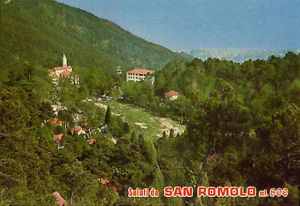 Between the IX and the X century many inhabitants of Villa Matutiana, in order to avoid the risk of raids and looting by the Saracen gangs, took refuge in the mountains surrounding the coastal village and planted new inhabited centres there. It seems that this is the origin of several villages that then arose in the immediate Matutian hinterland, including San Romolo.
Between the IX and the X century many inhabitants of Villa Matutiana, in order to avoid the risk of raids and looting by the Saracen gangs, took refuge in the mountains surrounding the coastal village and planted new inhabited centres there. It seems that this is the origin of several villages that then arose in the immediate Matutian hinterland, including San Romolo.
In 1522 the Hermitage of San Romolo was entrusted to the spiritual care of the Franciscan Order. In the Chapter held by the Order's superiors in Genoa on 22 December 1625 it was decided that the Monastery of Sanremo [Beside the Church of Santa Maria degli Angeli] should become the provincial seat of the novitiate of the Reformed.
As soon as it was informed of this decision, the Town Council raised formal and vibrant protests against the ousting of the Observants from the convent of Sanremo, which in the following days were joined by those of several citizens, who threatened a real popular uprising if it was implemented in this regard. Given the situation, Father Agostino da Genova dei Riformati asked for the intervention of the secular arm, which provided him with an armed galley; escorted by the Genoese soldiers, Father Agostino was able to enter the convent of Sanremo on 30th April 1626, where he sang a Te Deum of thanksgiving.
After losing the cause, the Observant Minors were forced to leave the convent of Sanremo and also the Hermitage of San Romolo, inhabited in that year only by two friars, Father Angelo da Perinaldo and Father Paolo da Sanremo.
The Reformed were particularly interested in the convent of the Hermitage, where they renovated the local religious building, despite the fact that the citizens were rather hostile towards them and deeply regretted the Observants.
However, it wasn't many years later that Pope Innocent X promulgated a bull which established the expulsion from the convent of San Romolo of the Riformati, who, having been informed of this decision on 10 December 1652, officially handed over the premises of the monastery and the annexed church to the vicar of the Bishop of Albenga only in 1654.
The latter appointed as his representative in Sanremo the Reverend Germano Bergiano, who on 4 October 1654 appeared before the convent of the Hermitage accompanied by the notary Sebastiano Sacheri. 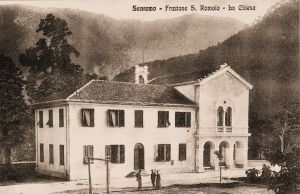 The superior father of the Reformed Geronimo Palmaro then handed over the premises of the convent to the bishop's representative, as well as some land located near the monastery.
The superior father of the Reformed Geronimo Palmaro then handed over the premises of the convent to the bishop's representative, as well as some land located near the monastery.
However, the Municipality immediately reacted to this transfer by sending the Council's notary-actuator Giacomo Gaudo, who declared the transfer of the convent and the land by the Reformed to the Reverend Bergiano as they were not the legitimate owners of the property transferred, which instead belonged to the Municipality, of which they were state property.
This conflict of competence and authority led to the result that in the following years the Hermitage fell into a state of complete abandonment, at least until the election of the new bishop of Albenga Francesco De Marini, who visited Sanremo in May 1656 to start a series of discussions with the local authorities on the destination of the Sanromolese convent, which probably ended with the overcoming of the main differences that arose between the civil and religious institutions regarding the destination of the monastery.
During the 17th century the conditions of the monastery and the Bauma of San Romolo had become increasingly critical, so much so that it seemed appropriate to entrust its management to a religious order. In June 1658 a Franciscan friar of the Observants, Father Angelo da Rossiglione, presented himself to the Town Council declaring himself willing to take possession of the Hermitage, but the proposal faded away mainly because of the firm opposition to this project on the part of the other current of the Franciscans present in Sanremo, the Reformed, clearly against the return of the Observants to the Hermitage.
A few years later, in May 1663, work was planned to enlarge and restructure the Hermitage, while on 22 May 1666 the Council decided to allocate the sum of 300 lire to have a statue of St. Romulus executed, at the same time electing two massari with the task of executing the resolution.
The Town Council wanted to give this event an exceptional solemnity by issuing a series of detailed provisions for its realization the following 18th June. It was decided to inaugurate the statue on the Sunday following the feast of Corpus Christi, during which a mass sung with blessing of the statue would be celebrated, while all the bells of the church of Sanremo would ring festively and the cannons located in the Castle, on the top of the Pigna and in the Bulwark of the Navy would fire some blanks.
At the end of June 1666 the statue of St. Romulus destined for the Bauma of the saint arrived in the city port aboard the ship of the patron Gio Antonio Martino in the presence of a huge crowd and the highest civil and religious authorities. A few days later, while waiting to transport the blessed statue to the Hermitage, the massari of Bauma obtained a grant of 100 lire to carry out repair work on the road leading to San Romolo, which were then carried out in the following months for a total cost of 160 lire for 160 days of work plus another 14 for finishing. Finally, on 12 September the statue of the saint was solemnly transported to the Bauma, where the Reverend Gian Battista Grossi celebrated the first mass in front of it. In the following years, however, the premises of the monastery and of the annexed church were gradually abandoned until, on 31st October 1678, the Town Council decided to intervene by sending secular priests to San Romolo with the task of reactivating the Hermitage premises, which were now falling down, and to give new dignity to the whole ecclesiastical complex.
The following year some priests belonging to the secular clergy finally settled in the Hermitage, who then began to carry out a praiseworthy religious and pastoral activity in Bauma, appreciated not only by the population, but also by the municipal authorities, who decided to reward this activity by allocating substantial funds between 1689 and 1693 for the repair and maintenance of the church and the other premises of the San Romolo Hermitage.
Between 1814 and 1815 the area of San Romolo was the object of a series of attacks by a group of ferocious deer wolves, which also caused several victims.
In 1832, on the initiative of the Bishop of Ventimiglia Giovanni Battista D'Albertis, the Opera Pia San Romolo was reorganised, already founded at the beginning of the eighteenth century to take care of the rights and the few assets due to the Bauma and the Hermitage of San Romolo. Initially, the bishop thought of simply annexing the premises of the Hermitage to the bishop's seminary by virtue of the Papal Bull issued by Innocent X on 13 October 1632, which donated the convents' assets to the bishops; later, however, Monsignor D'Albertis, perhaps on the advice of some of his collaborators, renounced this project, but continued with great commitment in his intention of restructuring the Opera Pia, which had been inactive for some time.
Gathered the Sanremo clergy on 31 August 1832 in the Oratory of San Germano, the bishop organised a consultation among those present in order to appoint three priests, who were to draw up new Regulations for the Opera Pia di San Romolo. The provicario foraneo Giacomo Margotti, Canon Giacomo Carbone and Don Antonio Massabò, who, under the direction of the enterprising bishop from Ventimiglia, had already completed the drafting of the Regulations twenty days later, were elected.
The text of the Regulations was finally officially approved by the bishop on 20 September 1832 with an episcopal decree, by which don Margotti was also appointed president of the association in order to quickly proceed with the application of the rules contained in the Regulations, which sanctioned the definitive reorganisation of the Opera Pia San Romolo, destined to continue its charitable activity for over a century.
On the night of 15 November 1944, during a sudden round-up by the Germans in San Romolo, Sanremo partisan Aldo Baggioli was killed.
(source: text Andrea Gandolfo "Storia di Sanremo", ed. Sanremo, Colombo, 2000; images private archive, Web)
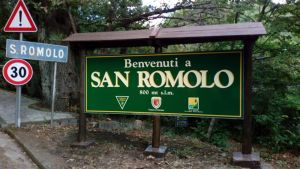
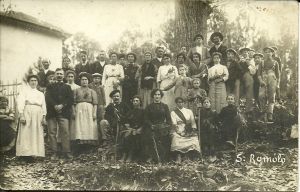 San Romolo has been since time immemorial the destination of trips and holidays of the Sanremaschi, so much so that the most important families who were in the area built villas where they could spend their holidays.
San Romolo has been since time immemorial the destination of trips and holidays of the Sanremaschi, so much so that the most important families who were in the area built villas where they could spend their holidays.
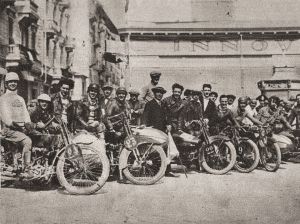 In the period between the two wars, speed and regularity races for motorbikes and cars were also organised, with departure from the town centre and arrival at San Romolo.
In the period between the two wars, speed and regularity races for motorbikes and cars were also organised, with departure from the town centre and arrival at San Romolo.
The bicycle race on the same route has also remained famous.
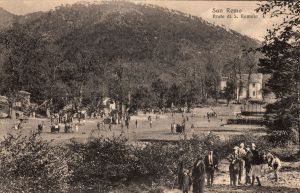
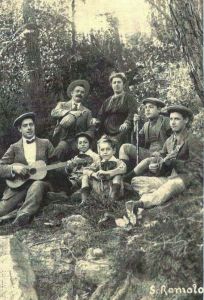 On the day of the patron saint's day, 13th October, the "Bauma", where according to tradition the saint lived and died, was opened to the public.
On the day of the patron saint's day, 13th October, the "Bauma", where according to tradition the saint lived and died, was opened to the public.
On this occasion, the people of San Remo mobilised and organised a traditional outing on the meadow of San Romolo. Most of them climbed up on foot, in droves, passing the word among their acquaintances to make their way in company, along the long mule track that starts behind the sanctuary of the Madonna della Costa and arrives at the destination.
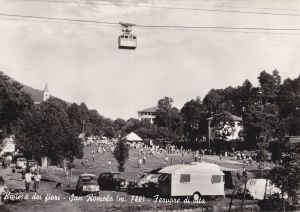
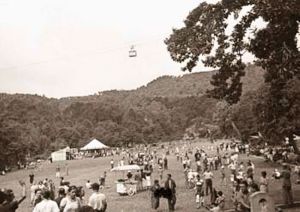 After the arrival of the Sanremo-Monte Bignone cable car, inaugurated in 1936, those who didn't go because they didn't feel up to it or couldn't walk, could use it to get to the San Romolo meadow to join those who were already there or even before them.
After the arrival of the Sanremo-Monte Bignone cable car, inaugurated in 1936, those who didn't go because they didn't feel up to it or couldn't walk, could use it to get to the San Romolo meadow to join those who were already there or even before them.
There was also a courier service to San Romolo and those who could afford it used their private cars.
Everyone brought traditional dishes and flasks of wine in baskets or bundles and ate them in company, sitting in the shade of the chestnut trees that surrounded the meadow.
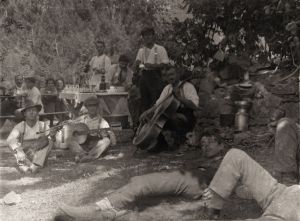 (personal anecdote) The writer's grandfather, Giuseppe Carbonetto, who in the 1920s had a café-bar at the top of Via Gioberti, towards the beginning of the 1930s ran a drink-restaurant service on the occasion of the feast of San Romolo and was the first to bring a coffee machine on a mule.
(personal anecdote) The writer's grandfather, Giuseppe Carbonetto, who in the 1920s had a café-bar at the top of Via Gioberti, towards the beginning of the 1930s ran a drink-restaurant service on the occasion of the feast of San Romolo and was the first to bring a coffee machine on a mule.
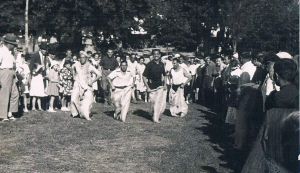
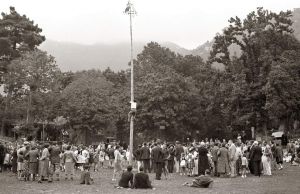 In the afternoons, there were always popular games that attracted many people, while some volunteers played music on the guitar, accordion and mandolin, and the youngest took advantage of the opportunity to have a good time.
In the afternoons, there were always popular games that attracted many people, while some volunteers played music on the guitar, accordion and mandolin, and the youngest took advantage of the opportunity to have a good time.
At sunset, albeit reluctantly, everyone headed home, tired but happy to have spent a carefree day, far from the worries of everyday life.
(source: text by Sergio Carbonetto; images from private archive)





